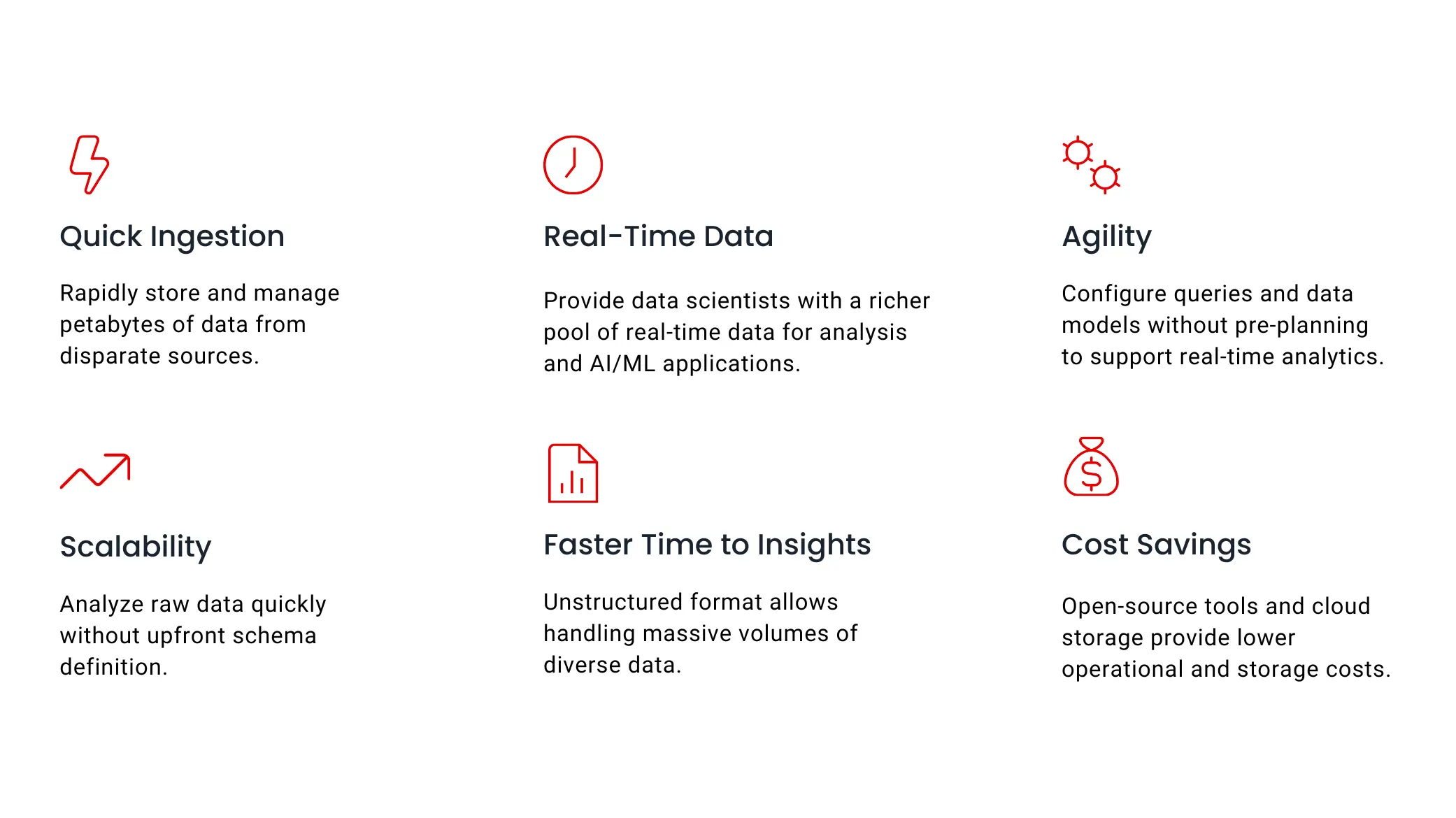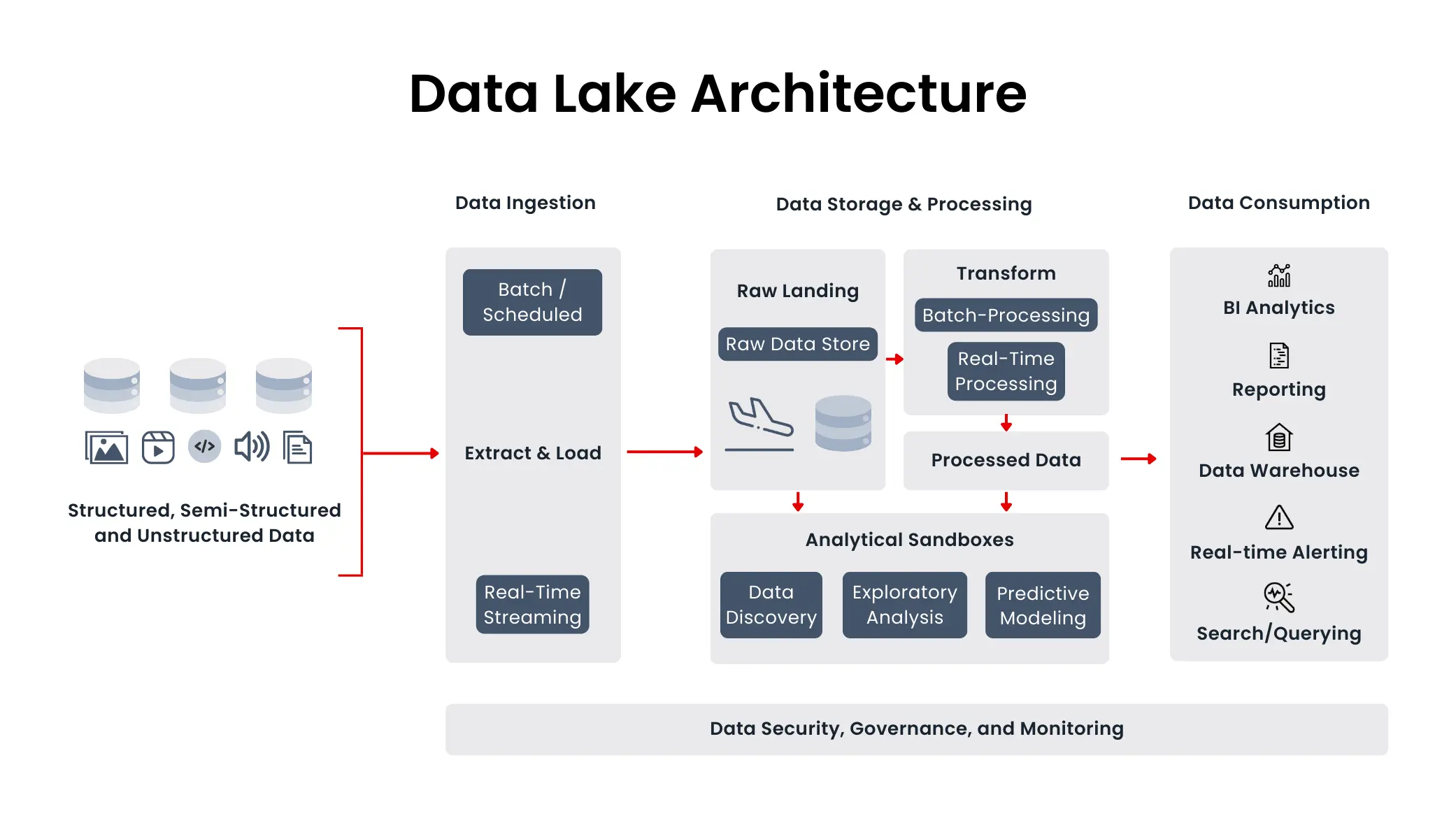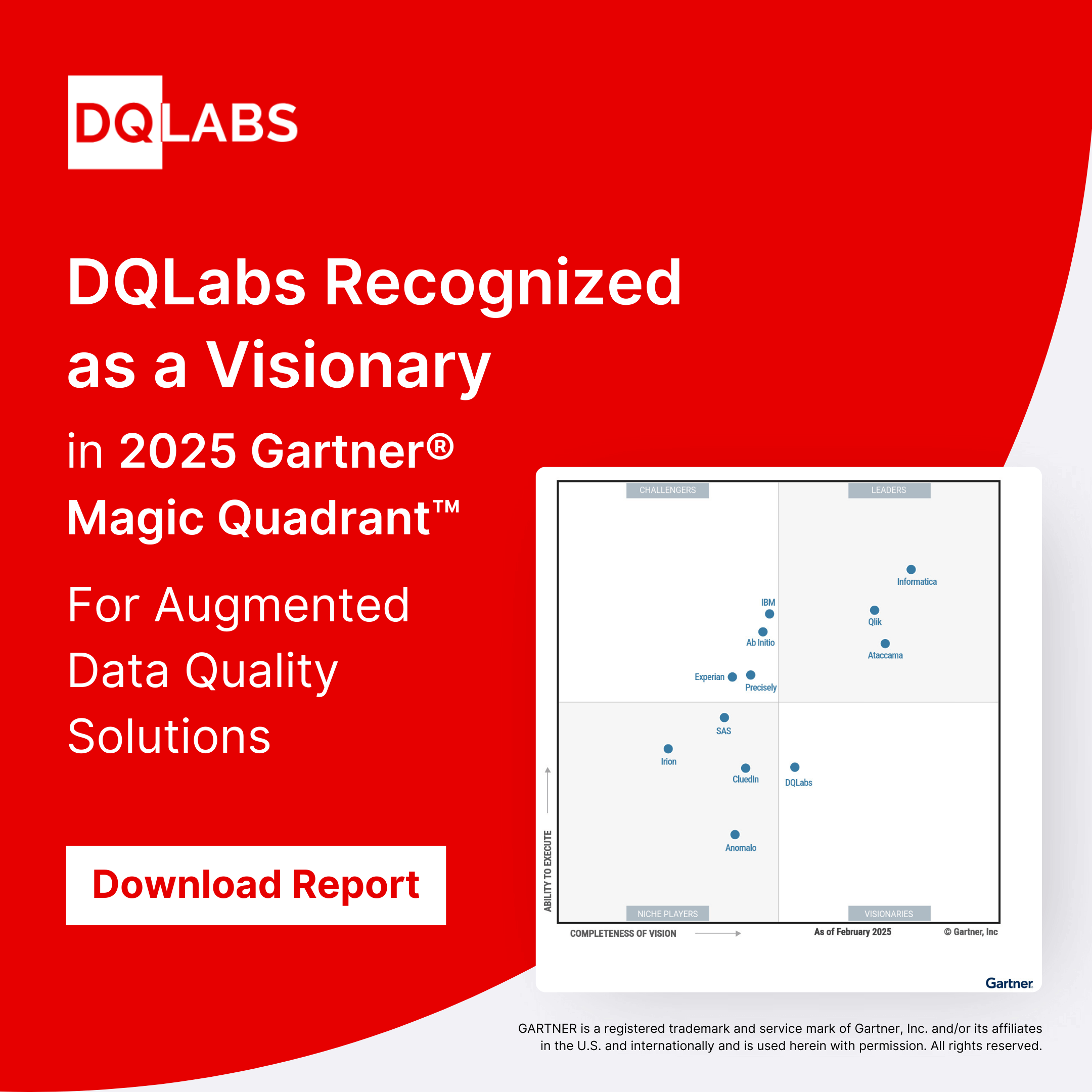A data lake is a centralized data storage repository designed to store, process, and secure a large volume of structured, semi-structured, and unstructured data. Unlike data warehouses, which require upfront organization of data, data lakes can store raw data without needing a predefined structure. This allows for flexibility in what type of information is stored and makes data lakes useful for various analytical needs that may evolve over time.
Data lakes utilize a flat storage architecture, instead of the hierarchical structure found in data warehouses. This flat architecture is optimized with object storage techniques that include metadata tags and unique identifiers. These tags and identifiers make it easier to find and retrieve specific data within the lake, improving overall performance.
Data Lake Benefits
Data lakes offer numerous benefits to businesses, including:

Kinds Of Data Lake Platforms
Data lakes are versatile solutions that cater to diverse data storage and analytical needs. They can be built on various platforms, with Hadoop being the most common but not the only option. Hadoop offers linear scalability and cost-effectiveness compared to relational databases.
However, relational database management systems (RDBMS) can also serve as platforms for data lakes, particularly when dealing with structured and relational data.
But the trend is shifting towards cloud-based storage solutions, which provide elastic scalability and cost-effectiveness. Cloud providers offer pre-integrated systems, allowing businesses to be up and running quickly. The object store approaches in the cloud also offer numerous benefits.
Businesses can adopt a hybrid approach, combining multiple platforms within a data lake. This logical data lake concept involves physically distributing data across various platforms. While this approach presents challenges, such as the need for specialized tools for federated queries and data virtualization, the necessary technology is available at the tool level.
In summary, data lakes can be built on different platforms, including Hadoop, RDBMS, and cloud-based storage solutions. The choice depends on factors such as data structure, scalability requirements, and cost considerations. Businesses can also opt for a hybrid approach, leveraging the strengths of multiple platforms within a logical data lake architecture.
Data Lake Architecture
The core components of a data lake architecture include:
Data Sources
Data sources can be classified into three categories: structured data from relational databases, semi-structured data like XML and JSON files, and unstructured data such as sensor data, videos, images, and social media content.
Data Ingestion
Data ingestion is the process of importing data into the data lake, either in batch or real-time modes. Batch ingestion transfers large chunks of data at scheduled intervals, while real-time ingestion immediately brings in data as it is generated. Tools like Apache NiFi, Flume, Apache Kafka, and AWS Kinesis are commonly used for data ingestion.
Data Storage and Processing
The data storage and processing layer is where ingested data resides and undergoes transformations. It consists of a raw data store section for staging data in its native format, a transformation section for cleansing, enriching, normalizing, and structuring the data, and a processed data section for storing the refined, trusted data suitable for analytics and machine learning.
Analytical Sandboxes
Analytical sandboxes serve as isolated environments for data exploration, discovery, machine learning, predictive modeling, and exploratory data analysis. They allow analysts and data scientists to experiment with raw and processed data without affecting the main data flow.
Data Consumption
The data consumption layer is where end users, such as data analysts, business analysts, and decision-makers, interact with the polished, reliable data through Business Intelligence tools like Tableau and Power BI to drive business decisions.
Underpinning these layers is a crosscutting governance, security, and monitoring layer that ensures data quality, access control, compliance, and oversight throughout the data lake architecture.

Key Features in Data Lake Tools
- Data Movement: Efficiently import data from multiple sources while preserving its original format, enabling scalability without the need for complex data structure definitions.
- Storage and Catalog: Store diverse data types securely, including relational data from operational databases and non-relational data from sources like IoT devices and social media. Get insights into data assets through crawling, cataloging, and indexing, ensuring robust security measures protect sensitive information.
- Data Governance: With role-based access enable data scientists, developers, and analysts with access to data using their preferred tools and frameworks.
- Connectivity: Ensure seamless access to a wide array of data types across databases, on-premises systems, SaaS applications, and other data lakes.
- Data Ingestion: Handle various data ingestion methods, including bulk, streaming, and CDC, with comprehensive connectivity options for diverse on-premises systems.
- Data Integration:Facilitate analytics without data movement, accommodating both open-source and commercial analytic solutions. Integrate data from diverse sources at any latency, facilitating the development of data flows and unified views for business consumption.
- Data Quality Assurance: Deliver high-quality data critical for analytics and AI/ML initiatives, particularly in cloud data lakes handling diverse data types.
- Metadata Management: Provide visibility into data inventory, business context, lineage, and value through robust metadata management, empowering efficient data governance and stewardship.
Best Practices to Follow
- Define goals and data types upfront for a well-organized lake.
- Treat your data lake as a central hub for all your data. Store everything in its raw format to preserve valuable details for machine learning and future analysis.
- Utilize indexing, partitioning, and caching for faster queries and responsiveness.
- Implement data validation and cleaning to maintain data integrity.
- Conduct regular audits, enforce access controls, and encrypt sensitive data at rest.
- Remember to anonymize any sensitive information before ingestion to comply with regulations and ensure long-term storage.
- Secure your data lake with granular access controls. View-based controls alongside role-based ones offer a more precise approach to user permissions.
- Finally, catalog your data at the entry point using metadata management tools. This empowers data scientists and analysts with self-service capabilities.
By following these best practices, you’ll transform your data lake from a potential liability to a valuable asset, delivering insightful data that drives informed decision-making throughout your organization.
Enterprise Data Lake Use Cases And Examples
Businesses across various industries are increasingly adopting data lakes to drive innovation, improve decision-making, and gain a competitive edge. Data lakes are significant for several reasons:
- Handling Diverse Data: Data lakes can store and process structured, semi-structured, and unstructured data from multiple sources, including social media, IoT devices, and enterprise applications. This versatility allows businesses to derive insights from a wide range of data.
- Real-Time Analytics: Data lakes enable real-time analytics by scaling to accommodate high volumes of incoming data, supporting low-latency retrieval, and integrating with stream processing frameworks. This is crucial in industries like finance and e-commerce, where immediate data-driven decisions are essential and could make a huge impact.
- Cost-Effectiveness: Data lakes are often built on cost-effective object storage, making them a more affordable option compared to traditional data warehouses. This allows businesses to store and analyze large volumes of data without incurring high costs.
- Machine Learning and AI: Data lakes provide the computational power and storage capabilities required for training sophisticated machine learning models. Companies like Airbnb leverage their data lakes to store and process vast amounts of data needed for their ML models, which predict optimal pricing and enhance user experiences.
- IoT Analytics: The Internet of Things generates massive amounts of data from various devices like sensors in machineries, cameras, etc. and data lakes can handle this volume and variety. General Electric uses its industrial data lake to optimize manufacturing processes and enable predictive maintenance in the aviation and healthcare sectors.
- Personalization and Search: Data lakes support advanced search capabilities and personalized recommendations by allowing companies to store diverse datasets that can be analyzed for specific functions. Netflix, for example, uses a data lake to store viewer data and employs advanced analytics to offer more personalized viewing recommendations.
Data Lake Challenges
While data lakes hold immense promise for data-driven decision making, their true potential often goes unrealized. Here’s why:
- Data Quality and Governance: Traditional data lakes lack built-in features for data quality checks, user permissions, and data deletion. This creates “data swamps” with unreliable and ungovernable information, hindering analysis and compliance.
- Performance Bottlenecks: As data volumes grow, querying data lakes with traditional engines becomes sluggish. Metadata management and improper data partitioning are some of the reasons behind this slowdown.
- Security Concerns: Securing data lakes is challenging due to limited visibility and control over data access. This makes it difficult to meet regulatory requirements and protect sensitive information.
These limitations force companies to maintain complex data architectures with siloed data in warehouses, databases, and other storage systems. But unifying data in a single location is crucial for implementing analytics and machine learning initiatives.
The answer lies in the data lakehouse, a new architecture that combines the benefits of data lakes with the structure of data warehouses.
The Lakehouse: A Data Lake’s Evolution
Here’s how it solves data lake challenges:
- Transactional Storage Layer: A lakehouse adds a layer that supports data transactions, enabling data updates, deletions, and improved data quality checks.
- Familiar Data Structures: It leverages data structures and management features similar to data warehouses, allowing for efficient querying with familiar tools like SQL.
- Open Format for Flexibility: Importantly, the lakehouse maintains the open data format of traditional data lakes, fostering collaboration and future-proofing data storage.
This hybrid approach empowers diverse teams:
- Data Analysts: Run SQL queries on the data lake for rich insights.
- Data Scientists: Join and enrich datasets for building highly accurate ML models.
- Data Engineers: Create automated data pipelines for efficient data movement.
- Business Intelligence Analysts: Develop visual dashboards and reports faster and easier.
All these functionalities can occur simultaneously on the same data lake, even as new data streams in. This eliminates the need for complex data movement, paving the way for a truly unified data ecosystem that helps you achieve massive business value. You can watch what’s a data lakehouse here:
Conclusion
Data lakes are a critical component within a vast data ecosystem. They offer a flexible way to manage and extract insights from information. Modern data lakes function seamlessly alongside a modern data quality platform like DQLabs, equipped with AI capabilities to proactively ensure data quality in your cloud data ecosystem. By working together, you could prevent data lakes from deteriorating into unusable “data swamps.”
